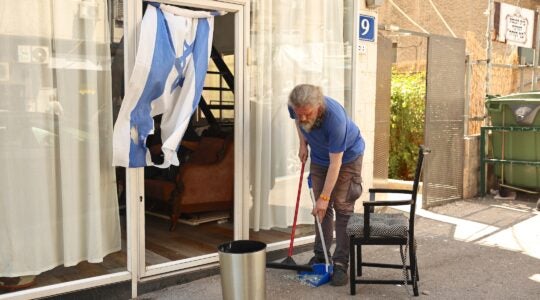A century from now, a child will be able to ask Pinchas Gutter, a Holocaust survivor, about his experiences and hear him tell his story. Or at least a 3-D hologram, created after hours of recordings, will be able to respond to questions posed to him by a generation that will have grown up after the last survivor has passed away.
Far from this world of state-of-the-art technology, my grandfather was born in a small isolated shtetl in northeast Poland. The old wooden synagogue near the center of town was burned by the Nazis and all the houses where the Jews once lived were long ago destroyed.
The fragments of gravestones in the Jewish cemetery are the last remaining physical evidence of a Jewish community that once numbered a thousand souls. An aging photograph of my grandfather standing by the gravestone of his father in the Jewish cemetery, during a visit in 1938, is one of a handful of images of our family that survive from that era.
Across Eastern Europe some 7,500 Jewish cemeteries still remain. Many are overgrown, built over and at risk of desecration. Most are in towns or villages where there are few if any Jews living today.
Yet increasingly, Jews are traveling to visit the places where their families came from, to visit the death camps where relatives were killed, and to see what remains of Jewish life now. These trips combine an intense quest for memory and history, often difficult and painful.
The growth of public interest in the Holocaust can in part be attributed to movies such as “Schindler’s List,” released in 1993. Scholarship on the Holocaust has developed over the years but popular movies and books have brought the history of the Holocaust to the attention of a wider public.
Today, new technology is opening the past up to us in ways that were inconceivable just a few years ago.
A search of Yad Vashem’s online database of names of Holocaust victims can lead one to the names of family members who perished in the Holocaust. It may describe where that person was killed and also yield the name of a town or a village from where the victim was from. Google Maps can show exactly where it is. I can contrast the time it would take my grandfather to drive to the nearest major town (Bialystok) today with the time it took to go on foot over 80 years ago (9 hours).
With Google Street View one can take a virtual walk through the streets where one’s family once walked and see how the town looks today. Websites about Jewish cemeteries in Eastern Europe, with photos and descriptions, provide a visible reminder of a shtetl’s history. Testimonies, historical materials and personal memoirs are increasingly available online. Automated translation websites enable us to access hitherto inaccessible documents. Jewish Gen, devoted to Jewish genealogy, has over 20 million records and can help make connections with both living and long-gone family members.
As the number of those who lived through the Holocaust diminishes, our technological capacity to delve into their lives, and the lives of those who perished, expands. As the physical evidence fades, software presents new opportunities to engage with the past.
Will these new technologies and opportunities sustain an interest in our history on the part of generations to come? Or will the shrinking universe of those with living memories of that world, as well as a declining ability to touch and feel the places where earlier generations once lived, lead to the fading of interest in what came before?
Talking to an interactive 3-D hologram, however technologically advanced, will never replace the experience of looking into the eyes of a survivor “who was there,” as Elie Wiesel says. Nor will clicking one’s way through a town on a computer screen substitute for walking the streets where a grandparent or a great-grandparent once lived. A virtual connection cannot replace a physical one.
For me, standing in the Jewish cemetery in the shtetl, 1938 photograph in hand, with my father, daughter and sibling saying Kaddish at the same place where my grandfather had stood by his father’s grave 78 years before, was a singular moment of history spanning five generations.
Every generation finds its own way to relate and to connect.
As a glance at the way in which teenagers communicate today through social media shows, it is a mistake to assume that the mode of communication and connection in one era is necessarily relevant for another.
Harnessing new technology can open up vistas towards lost worlds. It can capture memories and experiences through an approach that is relevant for the world of today. The ability to reach out to touch history in ways that were once unimaginable is both a challenge and an opportunity.
Ultimately, perhaps technology can help a new generation of Jews understand where they come from as they seek to work out where they are going.
Gideon Taylor is chair of operations of the World Jewish Restitution Organization.
The New York Jewish Week brings you the stories behind the headlines, keeping you connected to Jewish life in New York. Help sustain the reporting you trust by donating today.





